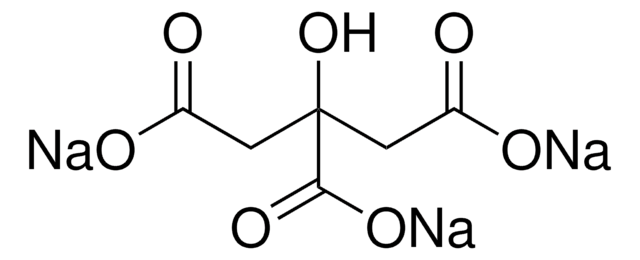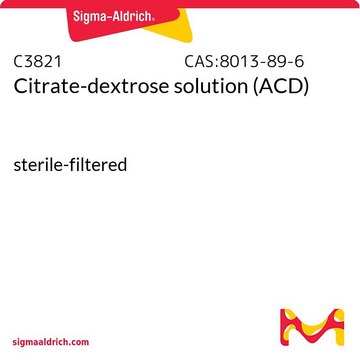C3434
Sodium citrate tribasic dihydrate
BioXtra, ≥99.0% (titration)
동의어(들):
Citric acid trisodium salt dihydrate, Trisodium citrate dihydrate
About This Item
추천 제품
제품 라인
BioXtra
Quality Level
분석
≥99.0% (titration)
양식
powder or crystals
불순물
Insoluble matter, passes filter test
pH
7.5-9.0 (20 °C, 0.1 M in H2O)
mp
>300 °C (lit.)
solubility
H2O: 0.1 M at 20 °C, clear, colorless
음이온 미량물
chloride (Cl-): ≤0.001%
sulfate (SO42-): ≤0.005%
양이온 미량물
Al: ≤0.0005%
As: ≤0.00001%
Ba: ≤0.0005%
Bi: ≤0.0005%
Ca: ≤0.005%
Cd: ≤0.0005%
Co: ≤0.0005%
Cr: ≤0.0005%
Cu: ≤0.0005%
Fe: ≤0.0005%
K: ≤0.01%
Li: ≤0.0005%
Mg: ≤0.0005%
Mn: ≤0.0005%
Mo: ≤0.0005%
NH4+: ≤0.001%
Ni: ≤0.0005%
Pb: ≤0.0005%
Zn: ≤0.0005%
흡수
≤0.010 at 260 in H2O at 0.1 M
≤0.010 at 280
SMILES string
O.O.[Na+].[Na+].[Na+].OC(CC([O-])=O)(CC([O-])=O)C([O-])=O
InChI
1S/C6H8O7.3Na.2H2O/c7-3(8)1-6(13,5(11)12)2-4(9)10;;;;;/h13H,1-2H2,(H,7,8)(H,9,10)(H,11,12);;;;2*1H2/q;3*+1;;/p-3
InChI key
NLJMYIDDQXHKNR-UHFFFAOYSA-K
유사한 제품을 찾으십니까? 방문 제품 비교 안내
생화학적/생리학적 작용
Storage Class Code
11 - Combustible Solids
WGK
WGK 1
Flash Point (°F)
Not applicable
Flash Point (°C)
Not applicable
개인 보호 장비
Eyeshields, Gloves, type N95 (US)
이미 열람한 고객
문서
Sigma-Aldrich presents an article about how proliferatively active cells require both a source of carbon and of nitrogen for the synthesis of macromolecules. Although a large proportion of tumor cells utilize aerobic glycolysis and shunt metabolites away from mitochondrial oxidative phosphorylation, many tumor cells exhibit increased mitochondrial activity.
Information on fatty acid synthesis and metabolism in cancer cells. Learn how proliferatively active cells require fatty acids for functions such as membrane generation, protein modification, and bioenergetic requirements. These fatty acids are derived either from dietary sources or are synthesized by the cell.
자사의 과학자팀은 생명 과학, 재료 과학, 화학 합성, 크로마토그래피, 분석 및 기타 많은 영역을 포함한 모든 과학 분야에 경험이 있습니다..
고객지원팀으로 연락바랍니다.




